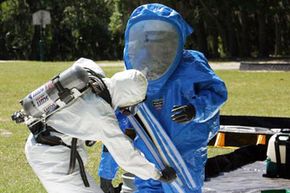Feared Chemical Agents
An effective chemical attack would use chemicals that are extremely toxic to people in small quantities. From least to most threatening, the most commonly feared agents are:
- Sarin -- Sarin is a nerve agent. Once inside your body, nerve agents affect the signaling mechanism that nerve cells use to communicate with one another. Sarin is a cholinesterase inhibitor -- it gums up the cholinesterase enzyme, which your nerve cells use to clear themselves of acetylcholine. When a nerve cell needs to send a message to another nerve cell (for example, to cause a muscle to contract), it sends the message with the acetylcholine. Without cholinesterase to clear the acetylcholine, muscles start to contract uncontrollably -- this eventually causes death by suffocation since the diaphragm is a muscle. It acts in five to 12 hours [source: Keyes]. It is not particularly difficult to manufacture, and if you were trapped in a one-cubic-meter closet with 100 milligrams of sarin in the air, inhaling it would kill you in 1 minute [source: Keyes].
- Cyclosarin -- Cyclosarin is another nerve agent. It works in the same way as sarin, but it is more than twice as toxic. You'd only need to be in the cubic-meter closet with 35 milligrams of airborne cyclosarin to die in 1 minute [source: Ellison]. Saddam Hussein's Iraq made cyclosarin during the Gulf War [source: Tucker].
- Soman -- Soman is also like sarin, but it acts faster, in 40 seconds to 10 minutes [source: Keyes]. It's about as toxic as cyclosarin [source: Ellison]. The Soviet Union stockpiled soman in the 1960s [source: Tucker].
- VX -- VX works in the same way as sarin, but it is a liquid, while sarin vaporizes. It is also ten times more toxic than sarin. Ten milligrams on the skin will kill a person [source: Keyes]. A sticky version exists that adheres to whatever it falls on [source: Harrison]. The United States made VX during the 1950s and 1960s [source: Tucker].
- Novichoks -- Novichoks are nerve agents. To make them, two ordinary chemicals are mixed to form a toxic product. As recently as 1990, at least three novichoks existed (novichok-5, novichok-#, and novichok-7), but whether large quantities exist today is unknown. All novichok agents are more toxic than VX. Some may be up to 10 times more toxic [source: Stewart]. They may also work differently than the nerve agents listed here, possibly rendering existing antidotes ineffective. The Soviet Union began making novichoks in the 1980s [source: Tucker]. In Russian, novichok means "newcomer."
Not all feared chemical weapons attack the nerves. Blistering agents, like mustard gas, blister the skin, destroy lung tissue and can kill people. But they are less deadly than nerve agents.
Advertisement
One of the problems with these chemical agents is that there is no easy way to protect yourself. On the battlefield, soldiers wear gas masks and complete skin coverings when chemical or biological attack is deemed possible. If a city were to experience a large-scale VX attack, people would have to be wearing a waterproof and airtight suit and a gas mask at the time of the attack in order to be protected.
